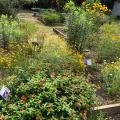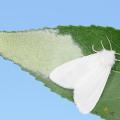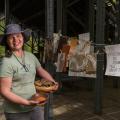Granulate Ambrosia Beetle
Blake Layton, Ph.D.
Extension Entomology, MSU, Feb. 2024
Granulate ambrosia beetle (GAB), is one of the most damaging insect pests of young trees in Mississippi landscapes, tree nurseries, and fruit orchards. Most of the damage occurs in early spring, just before, or as, trees are leafing out. A homeowner will notice the Japanese maple they planted two years ago fails to leaf out this spring. A commercial peach producer will lose a significant number of their two- and three-year-old trees. A commercial nursery will sustain 10 to 15% mortality in a couple of species of their container-grown hardwood saplings.
This non-native beetle was detected in the US in 1974, and it is now well-established throughout the state. Although we have a lot of wood-boring beetles in the state, Granulate ambrosia beetle, Xylosandrus crassiusculus, is one of the most important because it does not take many GABs to kill a young tree. Fortunately, attacks are sporadic and, even though GAB has several generations per year, most fatal attacks occur in the spring of the year on trees that are just breaking bud and beginning to leaf out. Like most tree borers, GAB is attracted to stressed or injured trees, as well as newly cut wood, but it will also attack apparently healthy trees, especially trees less than 3 inches in diameter. Such attacks are usually fatal because the beetle inoculates its galleries with a fungal disease, which grows within the tree and provides food for the larvae, and it takes only a few successful attacks to kill small trees.
GAB is one of the “shot-hole borers.” Many species of shot-hole borers occur in Mississippi, but most of the others restrict their attack to trees, limbs, or twigs that are dead or dying. Adult female GAB are about 1/10 inch long, reddish brown in color, and their heads are bent strongly downward, so that the head is not visible when the insect is viewed from directly above. The insects themselves are difficult to find and identify, but trees being attacked by GAB are often easy to spot because of the toothpick-sized sticks of tightly packed saw dust that project from the point of entry. These frass sticks are one of the more distinctive symptoms of a GAB attack. They may be either straight or curve downward and may be up to three inches long. Of course, rain and wind soon break these off, leaving only birdshot-sized, sawdust-packed entrance holes. A few of the other shot-hole borers will also produce these sticks of frass, but less consistently than GAB.
GAB attacks many species of hardwood trees, but it is particularly fond of species that are relatively smooth-barked, especially if they are growing in containers or have been recently transplanted. Some of the species we see it in most often are: Bradford pear, fig, crape myrtle, maple, sweet gum, magnolia, pecan, peach, ornamental cherries, and even woody vines like muscadine and shrubs like azalea, but there are more than a hundred other documented hosts. GAB does not attack conifers.
Attacks to nursery stock and recently planted saplings occur in the spring of the year just before or during bud break, and the number of attacks usually subsides after trees have leafed out. Trees that are growing in excessively wet soil are especially prone to attack. This includes trees planted in poorly drained areas of orchards or landscapes. Depending on weather and location the spring flight of GAB occurs from mid-February through April. Once GABs initiate an attack on a tree, they release pheromones that attract other GABs to the tree.
Prevention and Control: What can be done to prevent or control GAB? First, keep trees healthy and free of stress to reduce the likelihood of attack. This helps a lot even though GAB can and will successfully attack “apparently healthy” trees. Newly transplanted trees in landscapes, containerized plants growing in nurseries, and fruit trees that have recently been pruned are stressed, even when under the best of care, and these are some of the most common victims of GAB. Trees that are growing in low, poorly drained areas are especially susceptible, both in landscapes and in orchards. Keeping trees as healthy and free of stress and mechanical injury as possible makes them less prone to attack.
Although it makes sense to remove trees that are under attack and to burn or otherwise destroy the wood to keep beetles of the next generation from emerging and moving to other trees in the landscape/nursery/orchard, don’t be too hasty to do this. Trees that are already under attack are highly attractive to other GAB in the area, and GABs will usually come to a tree that is already infested rather than going to a nearby uninfested tree. This means you can leave newly infested trees standing a few weeks and use them as a trap to draw GABs away from other trees in the area. Just be sure to cut and destroy infested trees before the beetles have time to complete their life cycle. It takes around 55 days for GAB to complete a generation. By leaving an infested tree standing for three to four weeks after it is first attacked, you can get the trapping effect through most of the first/spring generation and still have time to destroy it before second generation beetles emerge.
Preventive insecticide treatments can be applied to trunks and large limbs of susceptible trees. The objective of such treatments is to provide an insecticide barrier on the bark that kills the beetles before they can bore into the wood and deposit eggs. When applied in late winter/early spring, trunk sprays can help protect susceptible nursery stock, young fruit trees, and newly transplanted trees from early spring attacks. But timing is critical because none of these products will kill beetles that have already bored into the trunk. These insecticide treatments work only by killing beetles just as they reach the tree and begin to bore in. Therefore, they have to be applied preventively.
The problem with preventive treatments is that GAB outbreaks are sporadic; a nursery may sustain heavy damage one year and little or none the next. Also, spring flight times vary from year to year. Commercially produced Lindgren funnel traps or home-made traps baited with ethanol can be used to monitor GAB flight activity and to time insecticide applications, but trapping requires enough time and effort that it is likely to be of interest only to commercial nurseries/orchards that have sustained significant losses to GAB in prior years. Remember, the traps are attractive to GAB, so don’t hang them right by the trees you are trying to protect. If you do use traps, be aware that many of the other bark beetles are also attracted to ethanol, sometimes in large numbers. This means it is important to be able to identify GAB and distinguish them from other bark beetles.
Insecticide options for GAB are limited. Soil-applied systemic insecticides, such as imidacloprid, do not work against GAB, but there are some useful contact insecticides. Several brand name products containing permethrin are available to homeowners and are labeled for use as trunk sprays to aid in control of wood-boring insects (Hi-Yield 38 Plus is one example). However, because the residual control provided by permethrin only last two to three weeks, repeated treatments may be necessary. A longer-lasting trunk treatment that can be used in commercial nurseries and landscapes is a product called OnyxPro (active ingredient is bifenthrin). However, Onyx Pro is a “Restricted Use” insecticide and must be applied by properly licensed private or commercial applicators. Homeowners who wish to use OnyxPro will usually need to hire a professional applicator to make the treatments. Onyx Pro is not labeled for use on fruit trees.
More Details on Prevention and Control in Specific Situations: The sporadic nature of GAB makes it difficult to predict when this pest will cause losses. The fact that it can cause damage in so many different situations makes it difficult to recommend control methods without considering the specific situation.
Home Lawns: Young trees that were planted in the last two to three years are most susceptible to GAB attack, but older trees are sometimes lost as well. Keeping all trees in the landscape as healthy and free of mechanical damage as possible is the best defense against GAB and other wood-boring insects. Applying repeated preventive sprays to all young trees in the landscape every year is not very practical. It is a bit like wearing your raincoat every day just in case it rains someday. The best plan may be to just “roll the dice” and wait to see if any trees are attacked. If a tree is attacked, promptly apply a preventive trunk spray to surrounding trees but leave the affected tree for or another three or four weeks, to trap beetles away from other trees. Then cut the tree and remove the wood before the beetles have time to complete their life cycle. It may be worth taking a more preventive approach on high-value trees, like that Japanese maple you paid $300 for, especially if there is a history of GAB problems in the landscape.
Commercial Landscapes: Here the approach can be similar to that for home landscapes. Losing a tree every once in a while may be preferable to spending all that time trapping and spraying preventively. But landscape managers may want to take a more preventive approach for newly-planted, large scale plantings. Losing even one tree from a group of saplings that have been planted in an evenly spaced pattern as screen or along a driveway can be pretty disappointing. In such cases, it may be worthwhile to apply two or three preventive trunk sprays of OnyxPro in late winter/early spring for the first two or three years after planting.
Commercial Tree Nurseries: This is where GAB can cause the most economic damage, either in container-grown stock or in-ground trees. Nurseries that have not had problems with GAB in past years will probably not be too concerned about this pest, though it could get your attention any spring now. Nurseries that have suffered heavy losses in past years will probably want to take a preventive approach, though such losses may not occur again this year even if you do nothing. Traps can be useful for determining when GAB are flying, but you will have to learn how to run them properly and how to identify GAB and sort them out from the other beetles that are attracted to the trap. You don’t have to count every beetle in the trap; you just have to see when you start catching GABs and then apply your first spray.
Bifenthrin products, such as OnyxPro, or permethrin products such as Astro or Perm-up, are materials of choice for preventive trunk sprays in nursery settings. Multiple sprays, applied at two to three week intervals, may be needed to cover the spring flight period. An air blast sprayer is the quickest and easiest way to spray, but this waste a lot of insecticide and sends insecticide into the upper canopy area where it can flare mites and other pests. It takes more time and labor to apply individual trunk sprays with a hand wand/spray gun, but this method provides better insecticide coverage, uses less insecticide and is less likely to flare outbreaks of other pests. If trees are attacked, don’t be too quick to remove and destroy them. Instead, move newly infested containerized trees to the outside of the nursery area, mark them so they won’t get shipped/sold, and use them as trap trees for a few weeks. Note that you must check trees regularly during late winter/early spring, looking for the first frass sticks, or you will not know when you have newly infested trees. Be sure to destroy trap trees before the next generation of beetles emerges. Some researchers and nurseries are even experimenting with the concept of intentionally creating sacrificial trap trees.
Commercial Fruit and Nut Orchards: Peach orchards seem to be where we have the most problems with GAB in Mississippi orchards, but commercial pecan saplings and muscadines are also attacked. It is difficult to predict when and where such attacks will occur. Young trees, three years old or less, seem to be most prone to attack, and this is where preventive efforts should be focused—if you decide to use preventive treatments. Traps can be useful for determining when to spray, but you will have to be willing to take the time to use them properly.
Onyx Pro is not labeled for peaches, but commercial fruit producers can use other pyrethroid insecticides, such as permethrin, cyfluthrin, or lambda-cyhalothrin. Brigade WSB (bifenthrin) can be used on pecans and muscadines. These products usually do not specifically include GAB in the list of insects controlled, but they can be applied to control other listed pests that occur at this time of year. Use the highest rate allowed and follow label directions. Do not apply insecticides when fruit trees are in bloom. Even though there may be situations when GAB flights occur during bloom, the damage to your pollinator insects may have more economic impact than losing a few trees to GAB. Sprays can be applied just before first bloom with the goal of having residual insecticide protection on the bark for the next couple of weeks.
Publications
News
A grant from Coast Electric will allow for a renovation of the Mississippi State University Crosby Arboretum’s pollinator garden. Pat Drackett, director of the arboretum, said the pollinator garden was established in 2001 as the Explorers’ Garden. It is a 3,000-square-foot space with a variety of native and other plants that helps teach visitors how to create havens for pollinators.
The 2020 Fall Flower & Garden Fest will be a virtual, educational event this year.
A tent for camping in the woods can be a good thing, but a tent filled with caterpillars in a pecan tree can be bad news for homeowners.
Success Stories
Robin Whitfield, who gave the child the paper, stands awestruck, watching her friend’s daughter use the flower to draw and color on the page.




